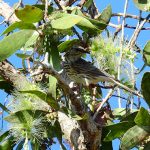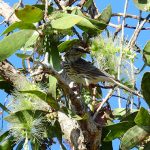BAR-BREASTED HONEYEATER
The Bar-breasted Honeyeater is a petite bird, measuring around 14 centimetres in length. Its plumage is predominantly olive-brown, providing excellent camouflage among the foliage. The most distinctive feature is the barred pattern across its chest, from which it derives its name. This barred pattern appears as a series of horizontal lines, giving the bird a unique and textured appearance. Its underparts are lighter, often a creamy white, contrasting delicately with the darker upper parts.
This honeyeater is primarily found in northern Australia, particularly across the tropical regions of Queensland and the Northern Territory. It thrives in a variety of habitats, including mangroves, woodlands, and forests, often preferring areas close to water. The bird’s adaptability to different environments underscores its resilience and versatility in the wild. These birds are often seen in small flocks, especially outside the breeding season, displaying a social nature that aids in foraging and protection against predators.
True to the honeyeater family, the Bar-breasted Honeyeater primarily feeds on nectar, which it skillfully extracts from flowers using its brush-tipped tongue. However, it is not solely dependent on nectar. The bird also consumes insects and spiders, which provide essential proteins, especially during breeding seasons when the nutritional demand is higher.
The breeding season for the Bar-breasted Honeyeater typically aligns with the wet season, from November to April, when food is abundant. The female constructs a small, cup-shaped nest using grass, bark, and spider webs, often positioned in a tree or shrub. She lays a clutch of two to three eggs, which are incubated for about two weeks. Both parents participate in feeding the chicks, showcasing a cooperative family dynamic.
While specific data on the longevity of the Bar-breasted Honeyeater is limited, many small passerine birds have a lifespan ranging from 3 to 5 years in the wild. Factors such as predation, habitat loss, and environmental conditions can influence their survival.
The Bar-breasted Honeyeater is known for its soft, melodious calls. These vocalisations are often a series of sweet, tinkling notes, which can be heard as the bird flits through the trees. Their calls serve various purposes, from attracting mates to signalling alarm or marking territory.
While currently not listed as threatened, the Bar-breasted Honeyeater, like many of Australia’s native species, faces challenges from habitat destruction and climate change. Efforts to preserve their natural habitats are vital to ensure their continued presence in the Australian landscape.


